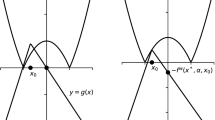Abstract
In this paper a constrained optimization problem is transformed into an equivalent one in terms of an auxiliary penalty function. A Lagrange function method is then applied to this transformed problem. Zero duality gap and exact penalty results are obtained without any coercivity assumption on either the objective function or constraint functions.
Similar content being viewed by others
References
Burachik R.S., Rubinov A.M. (2005). On the absence of duality gap for Lagrange-type functions. J. Ind. Manage. Optim. 1(1):33–38
Huang X.X., Yang X.Q. (2003). A unified augmented Lagrangian approach to duality and exact penalization. Math. Oper. Res. 28(3):533–552
Luenberger D.G. (1984). Linear and Nonlinear Programming. Addison-Wesley, Reading
Rockafellar R.T., Wets R.J.-B. (1998). Variational Analysis. Springer, Berlin Heidelberg New York
Rubinov A.M., Huang X.X., Yang X.Q. (2002). The zero duality gap property and lower semicontinuity of the perturbation function. Math. Oper. Res. 27(4):775–791
Rubinov A.M., Yang X.Q. (2003). Lagrange-Type Functions in Constrained Non-Convex Optimization. Kluwer, Dordrecht
Author information
Authors and Affiliations
Corresponding author
Additional information
The work of the authors was supported by the Australian Research Council (grant DP0343998), the Research Grants Council of Hong Kong (PolyU 5145/02E) and NNSF (10571174) of China, respectively.
Rights and permissions
About this article
Cite this article
Rubinov, A.M., Yang, X.Q. & Zhou, Y.Y. A Lagrange penalty reformulation method for constrained optimization. Optimization Letters 1, 145–154 (2007). https://doi.org/10.1007/s11590-006-0010-9
Received:
Accepted:
Published:
Issue Date:
DOI: https://doi.org/10.1007/s11590-006-0010-9




